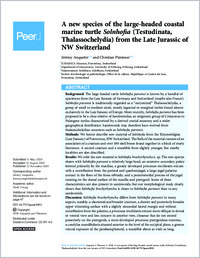A new species of the large-headed coastal marine turtle Solnhofia (Testudinata, Thalassochelydia) from the Late Jurassic of NW Switzerland
- Anquetin, Jérémy JURASSICA Museum, Porrentruy, Switzerland / Department of Geosciences, University of Fribourg, Fribourg, Switzerland
- Püntener, Christian Naturmuseum Solothurn, Solothurn, Switzerland / Section d’archéologie et paléontologie, Office de la culture, République et Canton du Jura, Porrentruy, Switzerland
-
2020
Published in:
- PeerJ. - 2020, vol. 8, p. e9931
English
Background: The large-headed turtle Solnhofia parsonsi is known by a handful of specimens from the Late Jurassic of Germany and Switzerland (maybe also France). Solnhofia parsonsi is traditionally regarded as a “eurysternid” Thalassochelydia, a group of small to medium sized, mostly lagoonal or marginal turtles found almost exclusively in the Late Jurassic of Europe. More recently, Solnhofia parsonsi has been proposed to be a close relative of Sandownidae, an enigmatic group of Cretaceous to Paleogene turtles characterized by a derived cranial anatomy and a wider geographical distribution. Sandownids may therefore have evolved from thalassochelydian ancestors such as Solnhofia parsonsi. Methods: We herein describe new material of Solnhofia from the Kimmeridgian (Late Jurassic) of Porrentruy, NW Switzerland. The bulk of the material consists of an association of a cranium and over 180 shell bones found together in a block of marly limestone. A second cranium and a mandible from slightly younger, but nearby localities are also described. Results: We refer the new material to Solnhofia brachyrhyncha n. sp. The new species shares with Solnhofia parsonsi a relatively large head, an extensive secondary palate formed primarily by the maxillae, a greatly developed processus trochlearis oticum with a contribution from the parietal and quadratojugal, a large jugal- palatine contact in the floor of the fossa orbitalis, and a posteromedial process of the jugal running on the dorsal surface of the maxilla and pterygoid. Some of these characteristics are also present in sandownids, but our morphological study clearly shows that Solnhofia brachyrhyncha is closer to Solnhofia parsonsi than to any sandownids. Discussion: Solnhofia brachyrhyncha differs from Solnhofia parsonsi in many aspects, notably: a shortened and broader cranium, a shorter and posteriorly broader upper triturating surface with a slightly sinusoidal lateral margin and without contribution from the palatine, a processus trochlearis oticum more oblique in dorsal or ventral view and less concave in anterior view, choanae that do not extend posteriorly on the pterygoids, a more developed processus pterygoideus externus, a condylus mandibularis situated anterior to the level of the occipital plane, a greater ventral exposure of the parabasisphenoid, a mandible about as wide as long,a relatively short symphysis, a lower triturating surface widened posterolaterally thanks to the presence of large laterally projecting dentary tubercles, a stouter and shorter coronoid process, a splenial positioned more anteriorly along the mandibular ramus, costo-peripheral fontanelles extending more anteriorly and posteriorly along the costal series, and an escutcheon shaped central plastral fontanelle formed mostly by the hypoplastra. In addition to the morphology of the new species, we also briefly discuss about observable ontogenetic variations and possible taphonomic origin of the assemblage.
- Faculty
- Faculté des sciences et de médecine
- Department
- Département de Géosciences
- Language
-
- English
- Classification
- Palaeontology
- License
- License undefined
- Identifiers
-
- RERO DOC 329660
- DOI 10.7717/peerj.9931
- Persistent URL
- https://folia.unifr.ch/unifr/documents/308822
Statistics
Document views: 138
File downloads:
- anquetin_puntener_2020_a_new.pdf: 177
